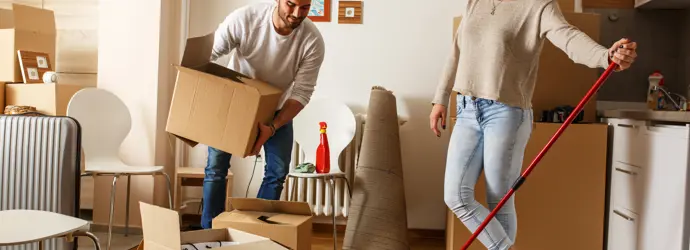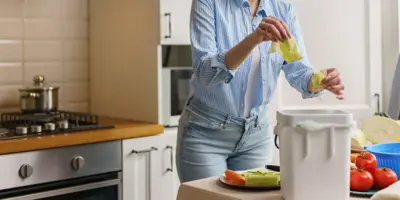
Everyone dreads the last days towards the end of a tenancy when property cleaning, packing up, and getting the ever-important deposit back become all consuming. While moving out is always chaotic, deep cleaning the house to ensure it’s in a suitable condition for the next tenants can add a little extra stress to those last few weeks.
With that in mind, we’ve created the ultimate moving out cleaning guide to help you get the house ship-shape and ultimately, your deposit back without hassle.
What is deep cleaning?
You will often see the words “deep clean”, especially regarding property cleaning. But what does it actually mean? Essentially, “deep cleaning” is a thorough clean and disinfecting of every corner of the house, including areas which are harder to reach on a day-to-day basis.
Deep cleaning is usually done to prepare for holidays or a special event, as well as towards the end of tenancy, although it’s recommended to deep clean your house at least once every six months.
To deep clean a house you will need:
- Industrial chemical resistant cleaning gloves
- Multi-surface cleaner
- Bathroom and toilet cleaner
- Specialist oven cleaner
- Window cleaner
- A vacuum cleaner
- Microfiber cloth or duster
- Extra-absorbent
- Rag or cloth-headed chamois mop and bucket
Deep cleaning your kitchen
The easiest way to deep clean a house is to tackle each room systematically, until every corner has been covered. Start with the rooms which are the most “lived in” and see a greater accumulation of grime over time. Kitchens are a good place to begin, because they often require a lot of work.
- Empty your shelves, fridge and cupboards of any leftover food beforehand to prevent waste. Pack away any loose appliances, such as microwaves, kettles and toasters.
- Clean the surfaces and cupboard interiors with a multi-surface cleaner and damp microfiber cloth, using the rough side of a sponge for any stubborn patches.
- Wipe down the kitchen sink and of any built up limescale deposits. Buff the taps with a paper towel for a sparkling finish.
- with a specialist oven cleaner and a damp sponge to remove hardened grease. Make sure to wipe down the hob, switches and air extractor too.
- Use a sponge or microfiber towel with hot soapy water to deep clean your fridge. Be careful when moving a fridge or freezer to clean behind, and make sure you have help when you attempt to do so.
- Vacuum and then mop the floor, scrubbing and de-grouting any floor tiles.
Deep cleaning your living room
- Start by moving any large furniture to the sides of the room so that you can clean behind them, making sure you have help if needed.
- Dust the furniture, ceiling and all corners using a microfiber cloth or duster. Check out our guide to dusting the whole house if you need any further info.
- Take down any curtains, draperies or blinds to wash before tackling the windows and sideboards with multi-surface spray.
- Vacuum the floor before mopping if you have wooden floorboards. Scrub all rugs and carpets using a specialist cleaner.
Deep cleaning a bathroom
- Bathrooms carry a lot of germs so make sure to disinfect the surfaces thoroughly, using specialist bathroom cleaner or bleach if needed.
- To clean the toilet, squirt toilet cleaner around the rim and leave for as long as you can. Wipe the outside of the toilet and seat, making sure to get behind as well.
- If there’s any mould in the bathroom, use a specialist mould remover on the affected area and leave for the recommended length of time, before wiping with a paper towel.
- Spray tiles with bathroom cleaner and wipe with a microfiber cloth. Use the rough side of a sponge for the grouting.
- Vacuum clean then mop the floor, scrubbing and de-grouting any floor tiles.
Deep cleaning your bedroom
After stripping the bedding to wash, the process for cleaning a bedroom is much the same as cleaning a living room. Make sure when vacuum cleaning that you move the bed in order to get under and behind it properly. Dust can also build up a lot in bedrooms so make sure to dust thoroughly, and tackle grimy skirting boards with warm, soapy water and a sponge.
Blue tack from posters can leave marks on bedroom walls which may be taken out of your deposit. If that’s the case for you, why not check out our guide for how to clean a wall so that it looks as good as new?
Once the main rooms have been deep cleaned, it’s always a good idea to go back over the house for any spots you might have missed. For other end of tenancy musts, learn how to defrost a freezer and, for tricks on dealing with messes and getting that deposit back, discover how to get red wine stains out of carpets and coffee stains out of upholstery – before the landlord/lady catches them!
Related articles
2 easy ways to make homemade musical instruments for kids
Looking for easy ways to have fun with your kids while teaching them how to recycle? Learn how to make musical instruments from waste material.

Why is my cat being sick? Symptoms, causes, and solutions
“Why is my cat sick?” Learn about the signs of illness in cats, the reasons why your feline friend might be sick, and how to treat a sick cat at home.

How to save money at home: simple saving tips and budgeting tips
Looking for simple ways to save money at home? Follow our budgeting tips and saving ideas to help you save money and provide more for your loved ones!

How to speed up composting: 10 hacks to accelerate your compost
Are you looking for ways to speed up your compost? Discover how to accelerate compost with our 10 hacks. Accelerating your compost has never been easier!

What to do with leftover food: creative ways to use food leftovers
From leftover chicken ideas, to what to do with leftover rice, find out how to get the most from your food leftovers.

Shortage of water: what is water stress and what can we do about it?
What is water stress, and what can we do to reduce its impact? Learn about water stress, its definition, causes, effects, and how to help water scarcity.

